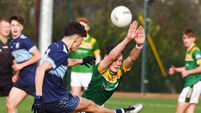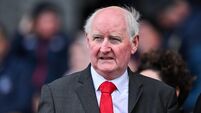Building Champions: A deep dive into Strength & Conditioning for young athletes

Cork GAA stars Amy O’Connor and Brian Hurley, who have both athletes have benefitted from S&C programmes. Picture Andres Poveda
SINCE its grand opening last September, the Mardyke Arena UCC has established itself as a premier training ground for local developing sports squads.
This elite gym offers a comprehensive Strength and Conditioning Development Programme designed to elevate athletes' performance.
By equipping them with a strong athletic foundation and essential knowledge, the programme empowers them to excel throughout their sporting careers.
This programme features dedicated weekly sessions, each lasting one hour and led by experienced strength and conditioning coaches.
Let's delve deeper into the programme's structure and the specific exercises employed to create well-rounded athletes.
The initial phase lays the groundwork for future growth. It begins with a thorough warm-up, preparing the players both physically and mentally for the main workout.
The coaches introduce various mobility drills to enhance joint range of motion, allowing for more efficient movement.
Running mechanics drills refine form and technique, promoting efficient power generation for explosive movements like sprinting.
Plyometrics, incorporating exercises like jump squats and box jumps, are also incorporated to improve an athlete's ability to generate explosive power.
Following the warm-up, the focus shifts to technical strength training.
Here, the coaches emphasize mastering the fundamental movement patterns that form the cornerstone of athletic performance.
These core movements include:
● Building lower body strength for explosive movements like jumping and sprinting.
Variations include bodyweight squats, dumbbell squats, and barbell squats, progressively increasing in difficulty.
● These exercises, like deadlifts and hip thrusts, target the posterior chain muscles, crucial for powerful movements like striking and running.
● Exercises like push-ups, shoulder presses, and bench presses enhance upper-body pushing strength, important for throwing and overhead control.
● Exercises like rows and pull-ups strengthen the pulling muscles, essential for powerful strokes in sports like swimming and rowing, as well as improved posture.
The programme utilises various equipment – bodyweight, dumbbells, and barbells – ensuring proper technique across all exercises.
This progressive approach caters to the different stages of development among the athletes.
Additionally, the programme incorporates a variety of movement types:
● Exercises like squats and lunges where both legs or arms work together.
● Exercises like single-leg squats and single-arm rows that target one leg or arm at a time.
● Movements that occur in a single plane, like bicep curls and overhead presses.
● Movements that involve multiple joints and planes of motion, like medicine ball throws and Turkish get-ups.
This diversity promotes well-rounded athleticism, ensuring athletes are prepared for the demands of their specific sports.
The final portion of the sessions addresses core stability and conditioning.
Core exercises like planks and anti-rotation exercises strengthen the torso, enhancing overall stability and proper technique, reducing the risk of injuries.
Conditioning games provide a fun and engaging way to improve cardiovascular endurance, agility, and reaction time, all crucial aspects of athletic performance.
Phase 2 focuses on power training and introducing more complex exercises.
This phase builds upon the previously learned movement patterns, incorporating exercises like barbell squats with explosive jumps like box jumps.
This combination allows athletes to refine their squat technique while adding a power element with the box jump.
Throughout this phase, coaches implement load management strategies.
This involves progressively overloading the athletes, meaning they gradually add more weight to exercises as they get stronger.
This approach ensures continued improvement and adaptation while minimizing the risk of overtraining.
As the team approaches their season, the programme transitions to a more specific approach, taking into account the demands of their specific sport and upcoming competition schedule.
Measuring Strength, Speed, and Power Tracking an athlete's progress is vital to ensure the programme is effective and meeting individual needs.
Regular assessments are conducted throughout the programme to measure key athletic qualities like strength, speed, and power. Some commonly used tests include:
● These tests measure an athlete's one-rep max (1RM) or the maximum weight they can lift for 3 or 5 repetitions in exercises like squats and deadlifts. Bench press tests can also be used to gauge upper body pushing strength.
● Flying sprints over short distances (e.g., 10 meters) assess an athlete's starting speed, a crucial component in many sports.
● Vertical jumps and standing broad jumps measure an athlete's ability to generate explosive power, essential for activities like jumping and pushing off the ground.
By monitoring these results, coaches can tailor the programme’s intensity and exercise selection for each athlete.
This personalised approach optimises the players' development and ensures they are on track Benefits Beyond the Gym.
This programme extends beyond simply lifting weights. Workshops on nutrition, sleep, recovery strategies, mindset, mental skills to optimize their training experience and overall physical & mental well-being.
Additionally, the focus on proper technique instills good movement habits that contribute to injury prevention and enhance performance.
This collaborative programme has proven to be a valuable addition to the young players' development.
With a combination of well-structured training sessions, expert coaching, and dedicated athletes, the programme is on track to build future champions.
The Mardyke Arena UCC is excited to continue supporting these talented athletes as they journey towards achieving their full athletic potential.







 App?
App?







